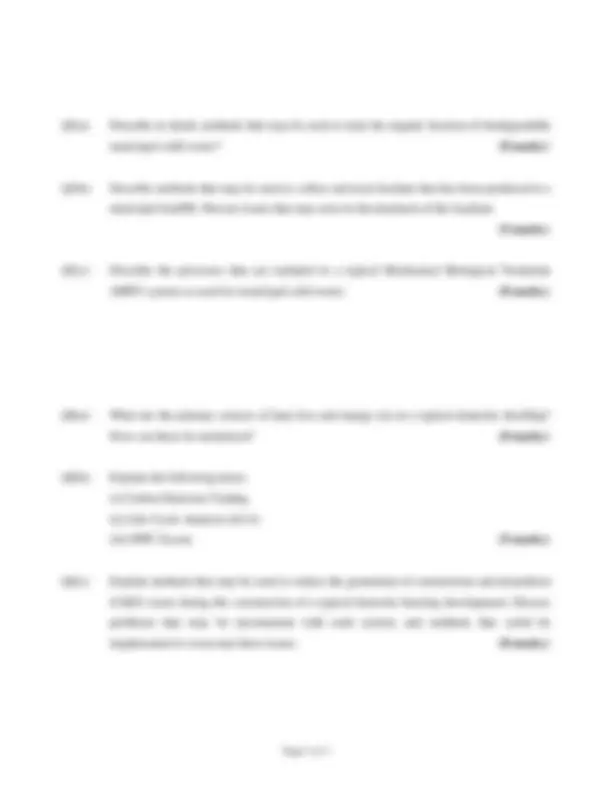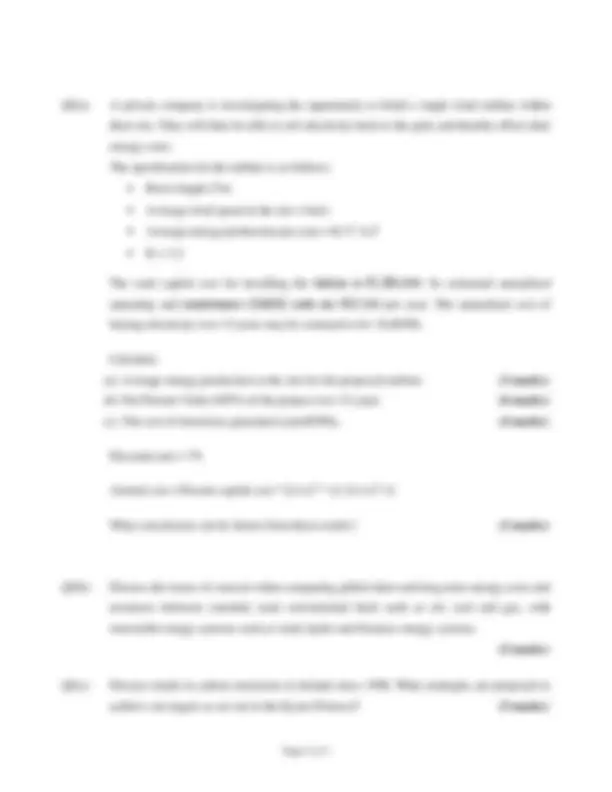




Study with the several resources on Docsity

Earn points by helping other students or get them with a premium plan


Prepare for your exams
Study with the several resources on Docsity

Earn points to download
Earn points by helping other students or get them with a premium plan
Community
Ask the community for help and clear up your study doubts
Discover the best universities in your country according to Docsity users
Free resources
Download our free guides on studying techniques, anxiety management strategies, and thesis advice from Docsity tutors
An examination paper for the environmental engineering 2 module (civl7007) at the cork institute of technology, ireland, for the bachelor of engineering in civil engineering program. The paper consists of four questions covering topics such as water quality, solar energy systems, wastewater treatment, and energy efficiency. Students are required to answer questions related to the water framework directive, human impacts, solar energy systems, anaerobic digestion, and energy sources.
Typology: Exams
1 / 4

This page cannot be seen from the preview
Don't miss anything!



Semester 2 Examinations 2010/
Module Code: CIVL
School: Building and Civil Engineering
Programme Title: Bachelor of Engineering in Civil Engineering
Programme Code: CCIVL_7_Y 3
External Examiner(s): Mr J. Murphy, Ms. M. Kyne Internal Examiner(s): Mr TL O’Driscoll
Instructions: Answer four questions.
Duration: 2 hours
Sitting: Summer 2011
Requirements for this examination:
Note to Candidates: Please check the Programme Title and the Module Title to ensure that you have received the correct examination paper. If in doubt please contact an Invigilator.
Q1(a) The Water Framework Directive sets the target of “good” water quality status for all water bodies in Europe by 2015. Explain what is meant by “good” water quality status and methods that are used to quantitatively measure this. (10 marks)
Q1(b) Explain the following topics in detail and how they may be addressed in an Environmental Impact Assessment for an onshore wind-farm in a remote rural location: (i) Human beings (ii) Soils (iii) Landscape (15 marks)
Q2(a) Describe the following solar energy systems: (i) Active solar energy in domestic houses. (ii) Passive solar energy in domestic houses. (iii) Photovoltaic solar energy systems for electricity production. (12 marks)
Q2(b) (i) Describe the primary components of a two-stage anaerobic digester which is used for the treatment of wastewater treatment sludge. (4 marks)
(ii) What are the by-products of this system, and how are they utilised? (3 marks)
Q2(c) List and describe the specific areas of importance which you would consider when submitting a planning application for an onshore wind-farm. (6 marks)
Q5(a) A private company is investigating the opportunity to build a single wind turbine within their site. They will then be able to sell electricity back to the grid, and thereby offset their energy costs. The specification for the turbine is as follows: Rotor length 27m. Average wind speed at the site = 6m/s Average energy production per year = K.V^3 .A.T K = 3. The total capital cost for installing the turbine is €1,300,000. Its estimated annualized operating and maintenance (O&M) costs are €32, 5 00 per year. The annualised cost of buying electricity over 15 years may be assumed to be 15c/KWh.
Calculate: (a) Average energy production at the site for the proposed turbine. (3 marks) (b) Net Present Value (NPV) of the project over 15 years. (6 marks) (c) The cost of electricity generated (cent/KWh). (4 marks)
Discount rate = 7%
Annual cost = Present capital cost * [(1+r)n^ * r] / [(1+r)n-1]
What conclusions can be drawn from these results? (2 marks)
Q5(b) Discuss the issues of concern when comparing global short and long term energy costs and resources between currently used conventional fuels such as oil, coal and gas, with renewable energy systems such as wind, hydro and biomass energy systems. (5 marks)
Q5(c) Discuss trends in carbon emissions in Ireland since 1990. What strategies are proposed to achieve our targets as set out in the Kyoto Protocol? (5 marks)